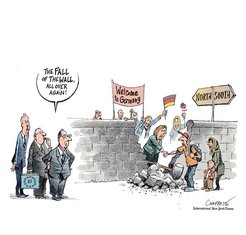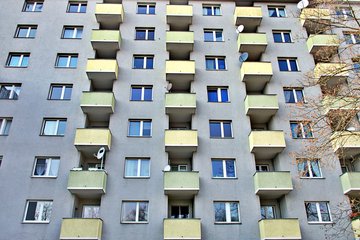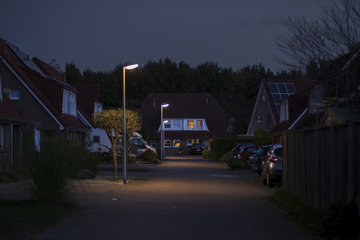Germany’s Second Turning Point?
by Steven Vertovec; in: MaxPlanckResearch 3/15

Current estimates suggest that Germany might expect about one million refugees this year. Chancellor Angela Merkel has clearly recognized that such an unprecedented influx will fundamentally change Germany. The Vice Chancellor, Sigmar Gabriel, has further surmised that Germany may well receive over 500,000 people per year in the near future. While he is confident that Germany will be able to successfully handle such a large-scale influx of migrants, he admits it will be the country’s biggest challenge since die Wende (the most common term for the “change” or “turning point” in German -society following the fall of the Berlin Wall and -German reunification).
Is the societal change that Germany now faces tantamount to die zweite Wende, or “second turning point?” A recent New York Times cartoon suggests as much, depicting “the fall of the wall all over again” with Angela Merkel and jubilant Germans welcoming refugees through a demolished wall between the global North and South. If the current inflow of people represents a social transformation of proportions similar to that of the German reunification, what might such change entail?
One should be cautious not to overstretch the comparison between what is being called the current refugee crisis and the Wende, because – just like the political cartoon – it is meant in a metaphorical sense. Suffice it to say that any profound event of this nature necessarily results in or will result in far-reaching political, economic and social restructuring. Twenty-five years after German reunification, the process is still not complete.
The former East and West regions of Germany still significantly diverge, both socio-economically and in terms of public attitudes. Transformations following the current, large-scale wave of immigration will also be far-reaching and will take decades to fully unfold. They will also likely have highly divergent outcomes across German society.
New migration leads to more migration
Gabriel’s conjecture that 500,000 or more new arrivals might reach Germany each year in the foreseeable future is likely correct. It is, in fact, right to assume that a growing number of people will immigrate into the country. After all, one thing we know from migration theory is that new migration leads to more migration. As people move across borders, the expansion of transnational social networks – now augmented by smartphone technology – facilitates information-sharing to family members and friends who stayed behind about modes and routes of travel, job-seeking, acquisition of housing and more.
Furthermore, the causes of present-day migration aren’t going away. Migration rarely has just one single trigger, and hardly ever is it either only forced or only voluntary. Migration has multiple roots. Most of the time, several factors compound or reinforce each other.
The reasons that drive people to migrate are manifold. They can be political (civil war, terrorism, political oppression or persecution), social (family strategies to improve living conditions), economic (chances of securing sustainable wages and access to goods and services), demographic (population size or density, especially with regard to the local labor market) or environmental (different types of soil degradation and consequences of climate change that endanger lives and livelihoods).
This interaction of multiple causes makes it increasingly difficult to find solutions to the migration problem – and that currently applies to almost every country from which new arrivals are coming to Germany in this refugee crisis. The constellation of compound migration causes is wholly different in each country, and none of these causes can be ameliorated in the near future. In fact, it is highly likely that particularly the driving forces related to environmental deterioration will continue to increase and will significantly influence all other causes.
It must be said that the influx of migrants from abroad is certainly not a new phenomenon in Germany. Over the past fifty years there have been successive waves of new migration. From the 1950s to the early 1970s, newcomers were comprised largely of Italians, Yugoslavs and Turks who shared a status of “guest workers” (Gastarbeiter). Family reunification during the 1980s and 1990s saw a further expansion of these national groups. Since the 1990s – when there was also a massive inflow of refugees from war-torn Yugoslavia – Germany has been witness to changing inflows from countries across the globe. This has amounted to a considerable diversification of the immigrant population.
The number of countries of origin from which migrants came to Germany kept rising. Today, people from more than 200 different nations live in Germany. Over the past twenty years, in Germany (as elsewhere around the world), a new migrant diversity has been layered on top of an earlier one.
These waves of immigration and diversification have been, on the whole, experienced favorably in Germany across all social backgrounds. This is shown in the annual “Integration Barometer” compiled by the Expert Council of German Foundations on Migration and Integration, which depicts a generally pragmatic and positive attitude toward issues of migration and integration among Germans and migrants alike. At the Max Planck Institute for the Study of Religious and Ethnic Diversity, a multi-disciplinary research project carried out in 16 German cities also demonstrates surprisingly high levels of contact between Germans and people with migration backgrounds.
Only 16 percent of Germans interviewed as part of the “Diversity and Contact” (DivCon) research project said they “never” had a conversation with people with migration backgrounds; about half said they have such contact “daily” or “weekly”. This shows that, for many people – especially in cities in western Germany – interaction between Germans and immigrants is a normal part of daily life. Moreover, such contact notably tends to be valued positively by all with or without a migration background.
Now, with the current inflows of migrants, an even newer diversity is being layered upon an already diversified population in Germany. Syrians, Afghans, Pakistanis, Eritreans, Somalis, Nigerians and Iraqis make up a large proportion of today’s new arrivals, along with continued high numbers of people from Serbia, Kosovo and Albania.
They are coming to Germany at the same time as the continued immigration of people from other countries, especially from Spain, Portugal, Italy, Greece, Poland and Bulgaria. Yet it is not increasing ethnic or national diversity that will pose the greatest challenges for German society. Rather, it is much more likely that the biggest challenges will surround the differing legal statuses of newcomers.
The biggest challenges will surround the differing legal statuses of the newcomers
Like most Western democracies, Germany sorts and deals with newcomers by way of differential migration channels, tracts and legal statuses. For example, there are: EU migrants, temporary or seasonal workers, highly skilled and corporate migrants, asylum seekers, officially recognized refugees, people with temporary residence permits or temporary suspension of deportation (Duldung), arrivals through family reunification, students, failed asylum seekers, people with lapsed visas and undocumented migrants.
Each status entails different opportunities and restrictions in many areas. These include issues concerning: permission to work, type, orientation and processes of integration into the labor market, type of employment contract, employment conditions and wages; length and nature of residence, prospects of family reunification, entitlement to welfare and healthcare services, access to education and public services, legal and political representation, chances for permanent settlement, and the possibility of gaining citizenship.
Migration statuses have implications for individuals’ earnings, health outcomes, housing, social network formation, integration into neighborhood life, and family dynamics. Legal status outcomes are therefore often intrinsically related to creating or perpetuating modes of social inequality, and assign people to situations and circumstances from which they often find it hard to escape.
So what might happen in the near future, when people keep migrating to Germany and the euphoric “Refugees welcome!” attitude has waned? According to available social-scientific analyses, the following developments are plausible: As with the previous waves of immigration, cordial if not positive encounters are likely to be commonplace. There will be frustration, but also eventual accommodation.
Language will almost certainly be a key frustration point. Yet more and more Germans will learn to find communicative middle ground with those who have less than fully competent German language skills. In turn, the newcomers will learn the ordinary, small and habituated proprieties, phrases, gestures, acknowledgements, and do’s and don’ts that Germans have internalized. Just like before the current wave of immigration, practices of uneventful, everyday living together across the country will go largely unnoticed.
Even though the generally positive atmosphere could very well last, there will doubtless be problems aplenty. Occasionally, social tensions will flare. Ugly incidents involving racist reactions will occur intermittently, but in isolation. Movements of the far right will probably not expand much beyond their current size (which is not very extensive at the moment). A lot will depend on whether and how migrants gain access to the labor market. (Previous experience has shown that this does not have a considerable impact on the unemployment rate. In fact, migrant integration into the labor market often creates some new jobs, while wages at the lower end of the scale potentially feel the pressure. However, there are few comparable cases of simultaneous immigration of such magnitude.) Municipal resources will be burdened, and institutions such as schools, healthcare and social facilities, as well as the housing market, will face significant challenges.
Stereotyping creates an image of the “good” and the “bad” immigrant
This will influence the political debate at all levels. And while some politicians will highlight successful examples of integration, others will leap at any negative instance to bark “I told you so.” This type of political discussion is sure to worsen should Germany experience an economic slump (for example if Chinese growth continues to slow down). Fingers will be pointed at migrants and the blame game will be played, exacerbated and exploited at every opportunity.
As far as positive or negative images, relationships and debates are concerned, there will be noticeable discrepancies not just between the traditionally open-minded larger cities, on the one hand, and the smaller towns and villages on the other, but especially between East and West. Before the refugee crisis, between 18 and 27.5 percent of the population in Germany’s western states came from a migration background, while only 3.4 to 4.6 percent of people in the eastern states were migrants. There is a common tendency to view immigration more negatively in places with fewer migrants.
Everywhere, however, public attitudes and representations will likely transform, or crystallize around, ethnicized images of “good” and “bad” immigrants. Through processes of stereotyping, in many people’s eyes, certain national groups will be positively valued while others are stigmatized. However, many actual problems, stigmas and forms of social stratification that arise around new migration will have far less to do with ethnicity, nationality and the presumably associated cultures than with migrants’ respective legal statuses, which have such a decisive impact on where and how people live. The crucial role of the media will be to ensure that their news coverage focuses less on ethnicizing problems and more on identifying the underlying structural causes.
The overall future picture is of a very uneven social landscape, with inequalities and discrepancies distributed unequally across the country. There will be more and less successful examples of “integration” (a word asked to do far too much work, since it can mean very different things when used in relation to education, the labor market, social relations, cultural values and language acquisition). The ongoing task for politicians, the media and academics will therefore be to define, identify and understand – in different places around Germany – the complex set of factors, processes, practices, institutions and resources that contribute to what counts as more or less success.
Today, it is conventional in Germany to use the phrase “since the turning point” (“seit der Wende”) to refer to any substantial post-reunification development. And while speaking of a “second turning point” might be a bit overstated, the social transformations facing Germany will be of such an order that, in the future, “since the refugee crisis” (“seit der Flüchtlingskrise”) might be as familiar a phrase.
The Author
Steven Vertovec was born in Chicago, Illinois in 1957. He studied anthropology and religious studies at the University of Colorado and later received his master’s degree from the University of California, Santa Barbara in 1982. He moved to the United Kingdom for his doctorate at the University of Oxford, where he subsequently became Professor of Transnational Anthropology and Director of the Centre on Migration, Policy and Society. In 2007, Steven Vertovec was appointed Scientific Member and Director at the newly founded Max Planck Institute for the Study of Religious and Ethnic Diversity, based in Göttingen. Vertovec has served as an expert and advisor on migration-related issues to British ministries, the World Bank, the European Commission, the G8 Forum and UNESCO. He consolidated his core theories on migration in the concept of superdiversity – a multi-dimensional understanding of increasing social complexity in many countries around the globe.












